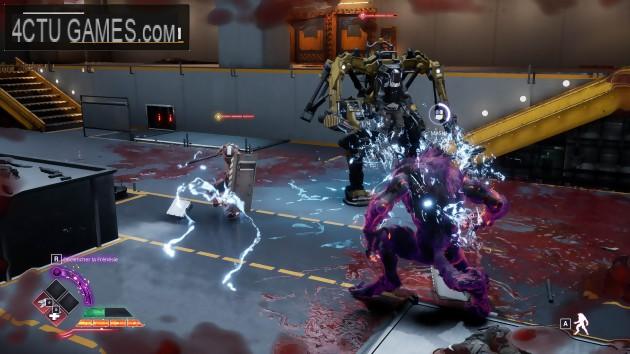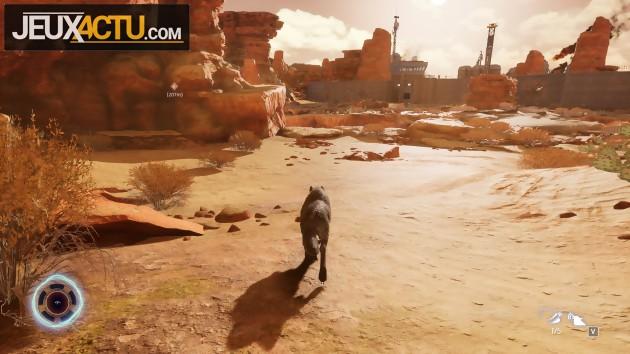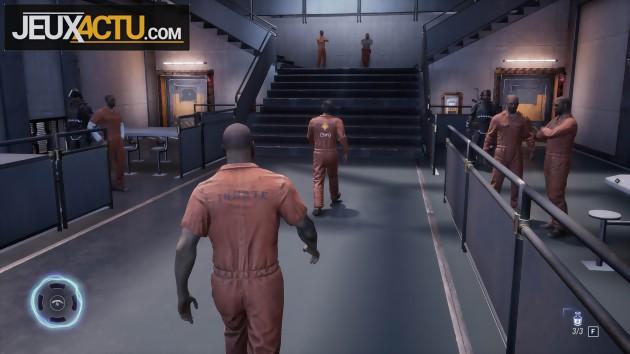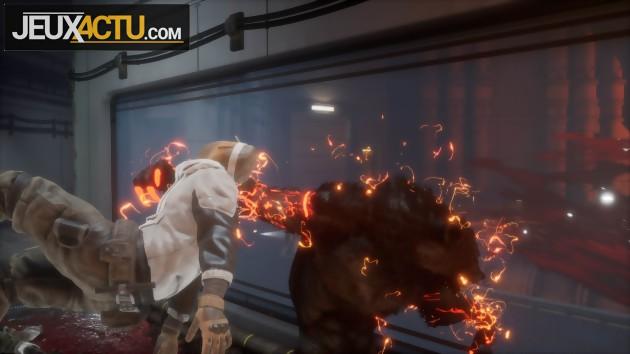Apart from a few werewolves, the Werewolf universe is extremely close to ours. Moreover Earthblood is part of current themes, where hypocritical megacorporations claim to fight against global warming while happily plundering the planet's resources. The main evil enterprise here is called Endron, and as the story unfolds we'll discover that it hides an even more diabolical scheme behind its lofty declarations of intent. To defend nature against these vile industrialists, what better than a pack of werewolves? The one we are presented with at the start of the adventure is notably made up of Cahal, the bald/bearded/muscled/tattooed lycanthrope hero that we play as, his human wife Ludmila and their daughter Aedana, who has not yet experienced her first transformation. If thereafter the scenario never leaves the beaten track, it still has the merit of taking place in a pleasant universe and too rarely adapted in video games. We are neither in a blockbuster nor in an auteur film, of course, but in a B series which completely assumes the confrontation of werewolves and exoskeletons!
The incorporation of supernatural and mystical creatures into a modern, industrial world works quite well, even if the overall writing is far from over the top. And let's face it, embodying a character capable of taking three different states (human, wolf and werewolf) is far from unpleasant. In his basic state, Cahal can dialogue with allied characters, even enemies in some cases, crouch to approach a guard from behind and twist his neck, use a crossbow, or even interact with switches and other computers. As you will have understood, we are therefore dealing with a game that emphasizes infiltration, this component being reinforced by the possibility of transforming into a wolf at will. The animal state makes it possible to move more quickly, to be more difficult to spot by enemies, and to use the many ventilation ducts present in the levels.
HE'S CRAZY ALF THE WOLF
As for the werewolf state, it usually occurs when we miss our infiltration attempt and things get out of hand. Cahal then transforms into a ferocious beast that violently unleashes itself on the poor humans around. The game offers us relatively classic and effective fights, which use a system made of fast, powerful and jumping attacks, dodges, special moves to be triggered thanks to a rage gauge, alternation between an agile and heavy position , and ultimate frenzy which allows you to benefit from both speed and power. And against all odds, it is this aspect of the game that turns out to be the most successful! The hero and the enemies move rather well, the clashes are bloody at will, and we feel good feelings of power, reinforced by the contrast with the phases of infiltration which precede the fights. Problem: Wereworld is a role-playing franchise, and this aspect turns out to be very limited in the end. We do have a skill tree, but it remains quite anecdotal and essentially allows us to improve our combat abilities.
As for the dialogues, they are most of the time of no importance, the different branches generally leading more or less to the same answers and most of the time having absolutely no consequence. The only exception to this comes from certain missions where it is possible to dialogue with the first enemies of the level. By answering their questions correctly, we can then infiltrate more naturally into their base. Knowing that the correct answers can only be known to the player if he has paid attention to the lore of the game (by listening to seemingly innocuous conversations or by reading documents), Earthblood then rises in our esteem. Alas, these flashy moments are the exception, not the rule. Moreover, the infiltration phases are hardly more exciting than the RPG aspect, because they are far too static.
BEWARE OF THE GAROUS
Most enemies remain planted in the same place, it is not possible to distract others from their rounds, and the sets use and abuse the same principle of "barriers" intended to help the hero hide. Whether you are in offices, laboratories, warehouses or in a prison, you will inevitably find rows of low walls which mark out the path in an all too obvious way. The Immersive Sim aspect that the adventure could have taken on also suffers from these overly systematic game mechanics. We feel too clearly that the air ducts are placed there only for the player, and not in a natural way, while any annoying camera will necessarily be located not far from a computer allowing it to be deactivated. During the ten or so hours necessary to visit all the levels from top to bottom, the adventure regularly blows hot and cold, each promising aspect being finally executed in a rather questionable way. In order to permanently ruin its chances with the most demanding players, Earthblood also suffers from an outdated technique. NPCs stiff as stakes, purely decorative ladders that cannot be used, heroes who slide a few centimeters to reach a precise position, sometimes extremely sketchy modeling, and uneven animations (often successful for wolves and werewolves, rather failed for humans) go hand in hand with a somewhat rushed endgame, which multiplies awkward transitions based on lazy fades to black. Cyanide Studio is therefore clearly not at its best here, Earthblood reminding us more of the average Of Orcs and Men than the pleasant Styx.


























